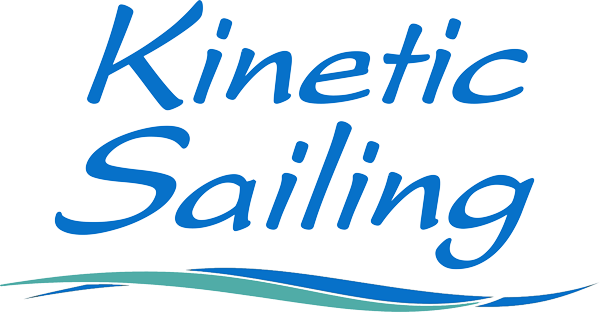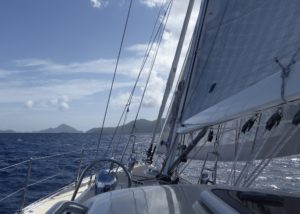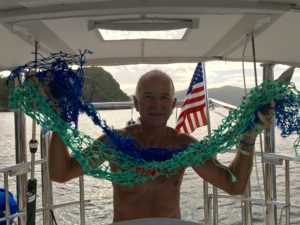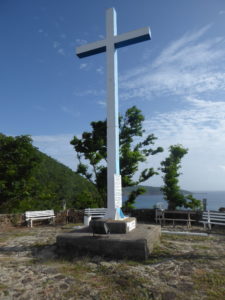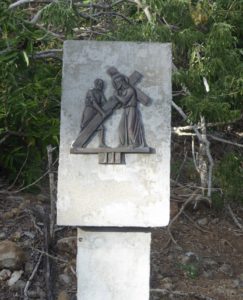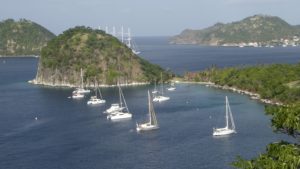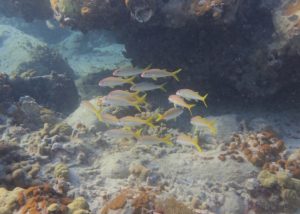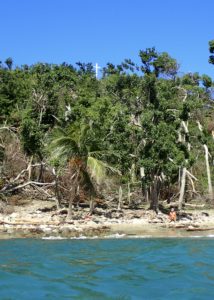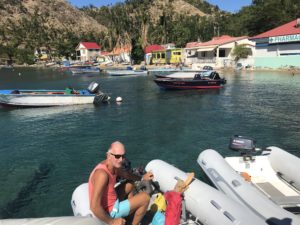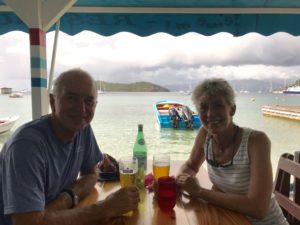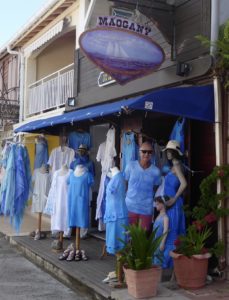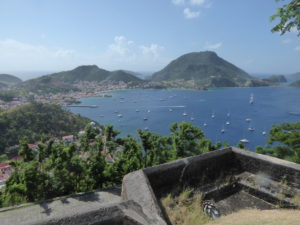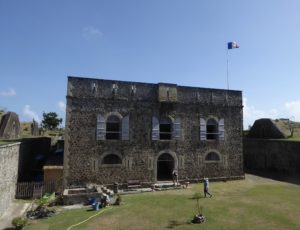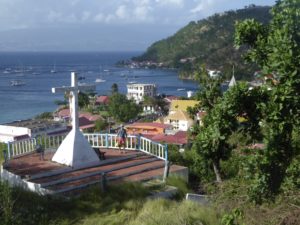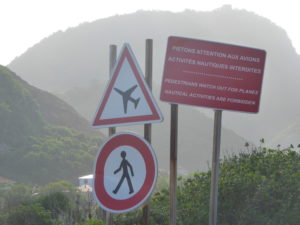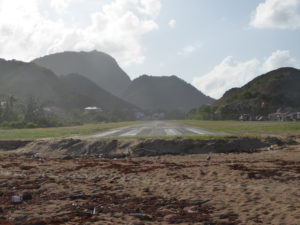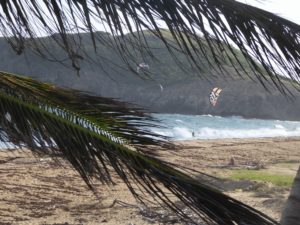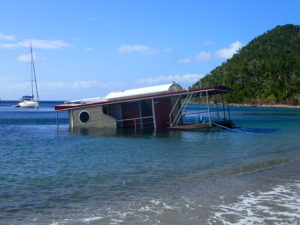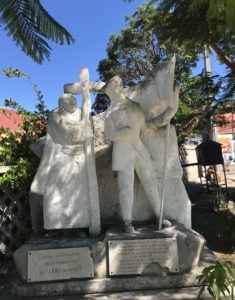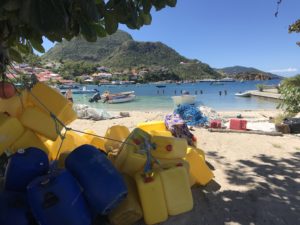Iles des Saintes (Islands of the Saints) is a small group of islands about 15 miles south of the Guadeloupe’s SW corner. Still part of French Guadeloupe, Les Saintes is closely linked to Brittany in the north of France, and still retains an active Breton fishing community. I’m writing this blog entry long after leaving Guadeloupe, because it’s hard to know where to begin. Les Saintes is overwhelmingly beautiful; we paid several visits to the island group and it’s multiple harbors, and took taking hundreds of photos. So rather than describe chronologically, I’ll describe by mouillage (anchorage).
Pain de Sucre
We sailed to Les Saintes from Pigeon on Dec 4th (2017), and came directly to the island of Terre-de-Haute. We have a favored anchorage at the western end of the island, called Pain de Sucre (Sugar Bread) for the prominent 200’ mini-piton at its head. On the waterway into Pain de Sucre we encountered a minefield of fishing floats, many comprised of clear 2 liter soda bottles. Fishing has its pros and cons! There is little space to anchor in this deep mouillage, as it has about 20 mooring balls installed now. We took a mooring, which is quite as easy as it sounds…. these mooring balls have no pendants, so one must “joust” to thrust a mooring line through the metal ring atop the float, picking it up on the opposite side before the bow blows down over the mooring ball, scraping off the bottom paint. In many cases, friendly neighbors come to the aid of newcomers, as happened this time.
Once secured, Andy jumped in for a swim and discovered that we had entangled a large mass of polypropylene fishing net in our prop. Luckily, we could pull it off with a boathook. Les Saintes Multiservices (LSM) maintains the moorings and provides services like laundry, customs and Immigration, wifi, and arranges technical services for yachts. They come out to the anchorage twice daily to collect mooring fees (an easy 13 Euro per night). If only they delivered baguettes!
We dinghied ashore to the dock of Hotel Bois Joli, and saw the extensive damage caused by Hurricane Irma. Several workers were restoring roofs, with expectation to be open for the New Year. Our goal in coming ashore was to hike to La Croix – a cross that stands prominently atop, facing out over the anchorage. A trail through the hotel grounds leads to another trail through a grassy meadow frequented by chickens and goats. Midway up, we found a statue of the Virgin Mary, overlooking the fleet below. We continued onwards to a steep dirt and stone path, discovering that the Stations of the Cross were displayed along the way. Each was a bronze bas-relief plaque on concrete base. Electrical wiring for lighting was in disarray, but the Stations were unmistakable. At the top of the trail was a plateau featuring La Croix – a white and blue shaded cross with a commanding view of Les Saintes and Guadeloupe. Last year we saw a covered area for services, but this was blown off the hillside by the hurricane, and lies near on the southern beach. Tucked away in the trees we found a small chapel to the Sacred Heart, with the 10 Commandments painted outside (in French), and votive candles and murals of the Virgin Mary (Light of the World, Salt of the Earth) inside.
Snorkeling at Pain de Sucre is generally good, and this visit was no exception. It’s easy to snorkel right from the boat to the rocky eastern wall; fish and coral are abundant. This year, the fish were joined by sheets of corregated metal – roofs blown from their buildings during the hurricane.
During a later visit to Pain de Sucre, we walked up and over to Anse Crawen, a secluded south-facing beach behind Pointe Bois Joli. We were the only beachgoers for hours, except for the goats and chickens. Andy practiced flying his drone up and down the beach (scaring a few goats along the way) and ventured the drone over water.
Anse du Bourg
After the relative seclusion of Pain de Sucre, we motored a mile east to the only town in Les Saintes, appropriately named Bourg des Saintes. This is the primary entry for Les Saintes, by air, ferry, or yacht. We chose the anchorage (moulliage) to the east of the ferry dock, generally more protected from wind waves and boat traffic. One successful joust of the mooring ball, and we were secure in Anse du Bourg, under the shadow of Fort Napoleon.
The town maintains a nice dinghy dock, supplies trash and recycling (wow) receptacles, and is very cruiser-friendly. We took care of business, then browsed some favorite shops – Maogany specializes in blue tie-dyed garments, scarves, hats – the color scheme draws us in every time. The French Isles are famous for traditional madras fabric, and Andy was in search of a replacement madras bucket hat. He also found a matching shirt and shorts! The town is centered on the Catholic Church, which now featured a fishing-themed nativity crèche – very creative. On the sidewalk next to the church, the chicken man has a wood-fired oven and serves the best chicken in the country. The town has boulangeries, patisseries, gelaterias, paperies, boutiques, groceries, and a great fruit and veg market. After purchasing and writing postcards/holiday cards (posted 18 Dec, arrived 2 Feb), we loaded up and enjoyed a feast of French delicacies onboard.
The next morning we went ashore to hike to Fort Napoleon – a national museum housed in a fort built in 1867, with a spectacular 360 degree view of Les Saintes. The fort is only open from 9-12, which works fine for us in the tropical heat. It’s a good climb, but absolutely worth it for the view. From the top, we could see our anchorage and surrounding islands, and also look into Baie Marigot and the fantastic beach at Baie Pompierre (we visited last year). The fort’s museum was a delightful surprise blend of history, art, botany and culture.
Well into walking mode, we struck out for more walking tour that afternoon. From the anchorage I could see a crucifix above the town, and enquired about it at the tourist office. Directions in hand, we climbed up the crucifix (Calvarie) and min-chapel, then walked west on Rue de Grande Anse to visit the cemetery. Above-ground crypts as we saw in Deshaies, with a monument to those killed in battle.
Finally, onwards to Grand Anse! This is a no-swimming beach on the windward side, clearly signposted with “no swimming, no watersports” because of the dangerous surf. The “pedestrians take caution” signs were because the airstrip ended at the beach! We walked south along Grand Anse where the more skilled kitesurfers were operating (watersport?), then along a road to the sheltered Anse Rodrigue. We walked back along the airfield and “suburban” homes, then through the south part of town to the dinghy dock and back to the boat. We got a 1-day “HotSpot” to do some internet admin onboard (loving Kinetic’s wifi signal booster). Tomorrow we’ll move and will move along to find better shelter, as the winds crept up to 20 knots and brought rolly conditions into the anchorage.
Isle Cabrit – Anse sous la vent
Wed, Dec 7th. The tradewinds have crept up to 20 knots for a few days, bringing gusts and rolly conditions to the anchorage, so we escaped Anse du Bourg for Ilet a Cabrit, a mile west. Also known as “Anse sous la vent” (bay under the wind), we still had some swirly gusts, but flat water for more comfortable conditions. The only thing missing was internet and baguettes – both easily obtained by a 1 mile dinghy ride across to the Bourg. We snorkeled the east and west sections of the beach, but visibility was limited by the wave action.
Andy took his machete and hiked up to Fort Josephine, widening the trail for others. Back on the beach, he was nearly “attacked” by an island cat – barely more than a kitten in size, but with quite an attitude. Not sure if the cat wanted food, or to warn off intruders – acted like a watch dog. Oddly enough, a band of beach chickens wandered by, and the cat took no notice. Weird. Next day, Andy offered the cat some fresh water, and it seemed that’s all she really wanted.
On Wed evening, we hosted happy hour onboard KINETIC for our friends on OYSTER and ALLADIN – cruisers we’d met in Deshaies and Les Saintes. On Friday, OYSTER hosted a pot-luck pasta dinner, and we were joined by Ward, whom we first met upon arrival in Antigua. Lots of sea stories swapped, and a great exchange of information on cruising ports. We made 100 gallons of water that day – the Rainman works well, once we can get it working. Happily supplied OYSTER with several gallons to supplement their supply.
A half-sunken houseboat/cottage was tied off at the beach – possibly towed there for more sheltered conditions during Hurricane Maria. While we were moored, we watched a team of divers attach inflatables to the structure and slowly bring it to the surface. The houseboat was attached to a towing tug, but we departed before the salvage was complete. It seemed the crew was living aboard the tug, saving the commute.
We love visiting Les Saintes, and look forward to stopping through again for a bit of French charm as we traverse the island chain.
